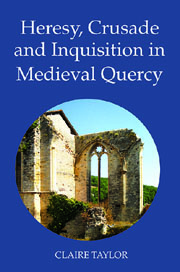Book contents
- Frontmatter
- Contents
- List of illustrations
- Dedication
- Acknowledgements
- Prefatory Note on Words
- List of Abbreviations
- Map 1 Medieval Quercy
- Map 2 Gourdon and its sphere
- The house of Gourdon
- Introduction
- 1 Investigating medieval Quercy: questions about sources
- 2 Medieval Quercy
- 3 War and its aftermath
- 4 ‘Heretical’ Quercy: the evidence gathered by c.1245
- 5 Heresy: a social and cultural life
- 6 Heresy and what it meant
- 7 The reshaping of Quercy
- Conclusion
- Bibliography
- Index
- YORK MEDIEVAL PRESS: PUBLICATIONS
2 - Medieval Quercy
Published online by Cambridge University Press: 05 February 2013
- Frontmatter
- Contents
- List of illustrations
- Dedication
- Acknowledgements
- Prefatory Note on Words
- List of Abbreviations
- Map 1 Medieval Quercy
- Map 2 Gourdon and its sphere
- The house of Gourdon
- Introduction
- 1 Investigating medieval Quercy: questions about sources
- 2 Medieval Quercy
- 3 War and its aftermath
- 4 ‘Heretical’ Quercy: the evidence gathered by c.1245
- 5 Heresy: a social and cultural life
- 6 Heresy and what it meant
- 7 The reshaping of Quercy
- Conclusion
- Bibliography
- Index
- YORK MEDIEVAL PRESS: PUBLICATIONS
Summary
Having noted the general truisms about Occitan society and that Quercy does not always conform to them, we should not be surprised at this. While it was increasingly orientated politically and historically towards the Toulousain, as we shall see, it was geographically peripheral to Languedoc and influenced heavily by Aquitaine to the north, even to the extent that after Quercy and the Agenais were recovered from the dukes of Aquitaine in the twelfth century the administrations they had established were simply taken over. But this does not mean that support for Catharism or Waldensianism would be strongest and most enduring in the south of the county, the region most obviously ‘Occitan’; things were not that simple.
Quercy's Early History: Political Foundations
The first ‘counts’ of Quercy were a family descended from one ‘Raoul’, who represented royal power at Cahors from AD 823. This family retained important viscounties after Charles the Bald's ally, one ‘Raimond’, subsequently became count, probably in the context of Norse incursions up the Garonne. From the 870s there is little direct evidence of Carolingian control in the county. In 932 a viscount Frotard of Cahors is attested in a donation to Beaulieu, in the Limousin. Frotard was a vassal of Count Raimond-Pons of Toulouse (922–c.950) for these estates, and gave them only in his presence and with his permission. By c.960 most of Quercy was held by Count Raimond I of the neighbouring Rouergue, Marquis of Gothia.
- Type
- Chapter
- Information
- Heresy, Crusade and Inquisition in Medieval Quercy , pp. 46 - 86Publisher: Boydell & BrewerPrint publication year: 2011



